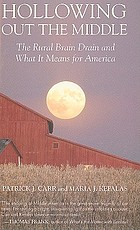Footnote mining from Paying for the Party, I ordered Patrick Carr and Maria Kefelas' Hollowing Out the Middle: The Rural Brain Drain and What it Means for America (Beacon Press, 2009) through ILL and read it last week. This slim volume is based on an ethnographic study Carr and Kefelas of three hundred high school graduates from a small, rural town in Iowa they call "Ellis." With a population of about two thousand, Ellis' economy is primarily agriculture and industrial; high school graduates who go on to college rarely return. Those who remain struggle with social isolation and financial solvency. Carr and Kefelas surveyed over three hundred Ellis high school graduates from the 1990s (who at the time of their study were about ten years out from the end of twelfth grade) and conducted approximately one hundred interviews of young adults who had either stayed in, left, or returned to their hometown. Hollowing Out attempts to describe the motivations and experiences of each group of individuals, and ends with some reflections on the role that social policy can (and cannot) play in supporting and reinvesting in rural life nationwide.
What Carr and Kefelas found was that high school graduates were tracked / self-sorted into a handful of broad categories: the Achievers and Seekers, the Stayers and Returners. Achievers were tracked from a very young age by their parents, school system, and socioeconomic status, to leave Ellis and attend a four-year college and possibly graduate school. Most will never return to live in their hometown, having built lives elsewhere with career opportunities and social connections. Seekers don't have the resources to attend a four-year college, even a good state school, and so often join the military; they will leave to explore the world, but have limited socioeconomic mobility and often struggle to find a place in the world beyond the armed forces. Stayers have dropped out of high school or obtained limited qualifications, usually struggle with un- or underemployment, wed and/or become parents much earlier than those who leave. They, and the Returners, often have negative perceptions of the world beyond their small town community -- either because they tried and failed to find a foothold there, or because they have no desire to leave the familiar. Returners are usually "Boomerang" individuals (often women) who may have relocated for an associates degree or attempted a four-year college education but never established connections that made them feel comfortable beyond Ellis. They can also sometimes be Achievers who, for a variety of individual reasons, return home (familial responsibilities, political ambitions, occasionally the right job at the right time). However, these "High Flyers" -- the ones so desperately sought by states with struggling economies -- are few and far between.
In the end, Carr and Kefelas encourage policy-makers to focus less on trying to lure these "High Flyers" back to their states, since individual motivations usually have little to do with initiatives to woo the Achievers into returning, and instead focus their resources on the Stayers and Returners who are already the backbones of their communities and remain an un- and undertapped social and economic resource.
The authors do, eventually, touch upon some of the non-economic reasons that Achievers and others who leave Ellis may resist returning -- reasons such as prioritizing racial diversity or acceptance of queer identity and relationships -- that I think should have been foregrounded a bit more. Granted, interesting work is currently being done to highlight the lives of queer folk in rural America. Rural Americans are not inherently more or less prejudiced toward Othered groups than urban or suburban Americans. However, smaller communities are often self-selecting and more homogeneous; they're also often extremely isolating for those who are somehow different, even if they (we) don't experience overt prejudice or violence. Simply put, it was harder for me, as a bi woman, to find potential female partners (and even potential male partners!) in a medium-sized Midwestern town than it is.
And now, as a married lesbian, I have structural as well as cultural reasons not to return to Michigan: our marriage would not be honored by the state government. So whenever I read about state campaigns for professional Michiganders to return and invest in the state where I grew up -- and which I continue to love in many respects -- I admit I'm not exactly feeling the love. Many of us Leavers have left precisely because our communities scarred us, deeply, and returning to live there would open old wounds.
But in the end, I was uneasy with the way in which the authors' solution seems to encourage a "circling the wagons" approach to social policy, where the parochial reasons that people leave certain communities are glossed over rather than challenged. I wanted them to dig more into the ways, for example, racial prejudice, the gendered division of labor in working class communities, or anti-gay sentiment not only drives Achievers away but harms those who stay behind. Not every person who embodies a marginalized identity (queer, physically disabled, non-white, Muslim, etc.) has the resources to "get out of Dodge" even though we may have strong push-pull factors to do so. While I'm comfortable with studies of rural America that ask us to reconsider our prejudices toward "hicks" living in "flyover" states, the fact that homogeneity was a fact of small town life the authors' touched on but never developed is something I found troubling.
Still, I'd recommend this book to anyone with an interest in how education and social policy reproduce class and cultural divides here in America. The personal narratives woven throughout the sociological analysis will resonate with many readers who grew up in rural or quasi-rural Midwestern communities (raises hand), and provoke reflection beyond personal experience toward broader social trends.

No comments:
Post a Comment